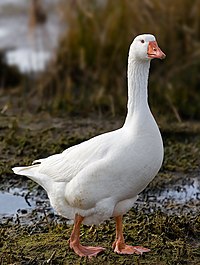
Photo from wikipedia
Simple Summary The goose is an economically important waterfowl and is one of the first domesticated poultry species. However, population structure and domestication in goose are understudied. In this study,… Click to show full abstract
Simple Summary The goose is an economically important waterfowl and is one of the first domesticated poultry species. However, population structure and domestication in goose are understudied. In this study, we found that Chinese domestic geese, except Yili geese, originated from a common ancestor and exhibited strong geographical distribution patterns and trait differentiation patterns, while the origin of European domestic geese was more complex, with two modern breeds having Chinese admixture. In both Chinese and European domestic geese, selection signatures during domestication primarily involved the nervous system, immunity, and metabolism, and genes related to vision, skeleton, and blood-O2 transport were also found to be under selection. In particular, we identified that two SNPs in EXT1 may plausibly be sites responsible for the forehead knob of Chinese domestic geese, and that CSMD1 and LHCGR genes may associate with broodiness in Chinese domestic geese and European domestic geese, respectively. Our study provides new insights into the population structure and domestication of geese. Abstract The goose is an economically important poultry species and was one of the first to be domesticated. However, studies on population genetic structures and domestication in goose are very limited. Here, we performed whole genome resequencing of geese from two wild ancestral populations, five Chinese domestic breeds, and four European domestic breeds. We found that Chinese domestic geese except Yili geese originated from a common ancestor and exhibited strong geographical distribution patterns and trait differentiation patterns, while the origin of European domestic geese was more complex, with two modern breeds having Chinese admixture. In both Chinese and European domestic geese, the identified selection signatures during domestication primarily involved the nervous system, immunity, and metabolism. Interestingly, genes related to vision, skeleton, and blood-O2 transport were also found to be under selection, indicating genetic adaptation to the captive environment. A forehead knob characterized by thickened skin and protruding bone is a unique trait of Chinese domestic geese. Interestingly, our population differentiation analysis followed by an extended genotype analysis in an additional population suggested that two intronic SNPs in EXT1, an osteochondroma-related gene, may plausibly be sites responsible for knob. Moreover, CSMD1 and LHCGR genes were found to be significantly associated with broodiness in Chinese domestic geese and European domestic geese, respectively. Our results have important implications for understanding the population structure and domestication of geese, and the selection signatures and variants identified in this study might be useful in genetic breeding for forehead knob and reproduction traits.
Journal Title: Biology
Year Published: 2023
Link to full text (if available)
Share on Social Media: Sign Up to like & get
recommendations!